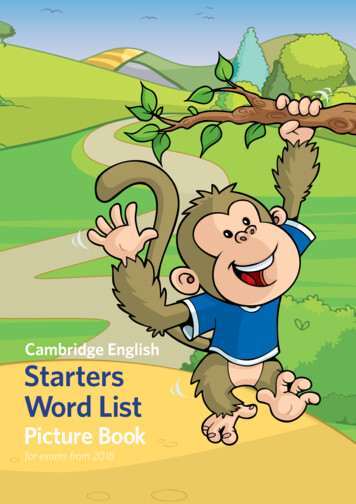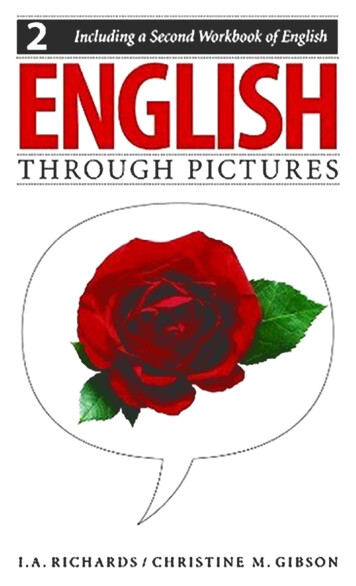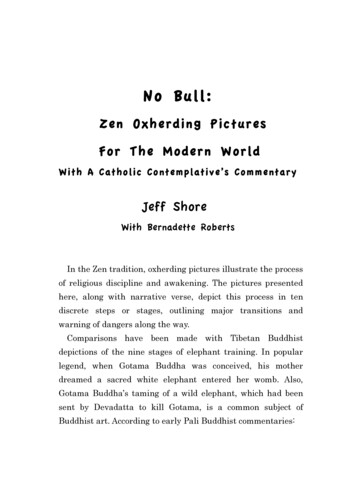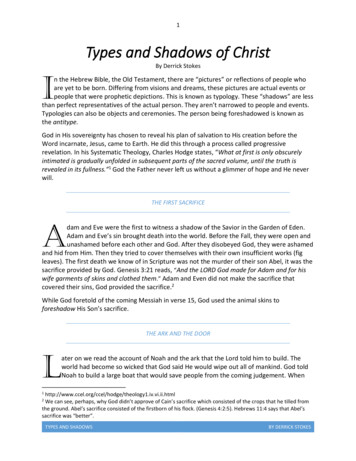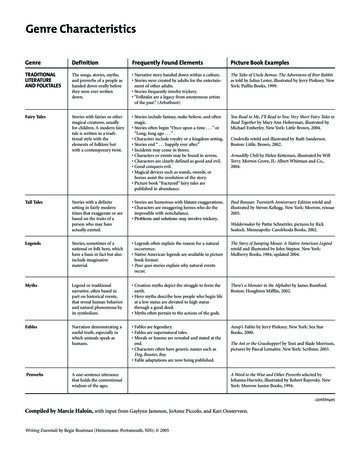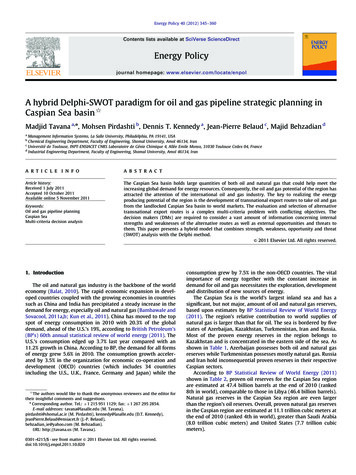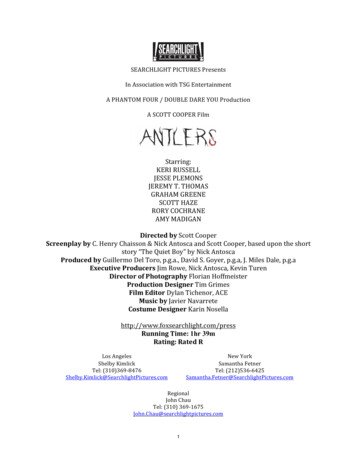
Transcription
SEARCHLIGHT PICTURES PresentsIn Association with TSG EntertainmentA PHANTOM FOUR / DOUBLE DARE YOU ProductionA SCOTT COOPER FilmStarring:KERI RUSSELLJESSE PLEMONSJEREMY T. THOMASGRAHAM GREENESCOTT HAZERORY COCHRANEAMY MADIGANDirected by Scott CooperScreenplay by C. Henry Chaisson & Nick Antosca and Scott Cooper, based upon the shortstory “The Quiet Boy” by Nick AntoscaProduced by Guillermo Del Toro, p.g.a., David S. Goyer, p.g.a, J. Miles Dale, p.g.aExecutive Producers Jim Rowe, Nick Antosca, Kevin TurenDirector of Photography Florian HoffmeisterProduction Designer Tim GrimesFilm Editor Dylan Tichenor, ACEMusic by Javier NavarreteCostume Designer Karin Nosellahttp://www.foxsearchlight.com/pressRunning Time: 1hr 39mRating: Rated RLos AngelesShelby KimlickTel: mNew YorkSamantha FetnerTel: omRegionalJohn ChauTel: (310) 369-1675John.Chau@searchlightpictures.com1
From the visionary world of acclaimed director Scott Cooper (CRAZY HEART, HOSTILES) andhorror maestro Guillermo del Toro (THE SHAPE OF WATER) comes ANTLERS. In an isolatedOregon town, a middle-school teacher (Keri Russell) and her sheriff brother (Jesse Plemons)become embroiled with her enigmatic student (Jeremy T. Thomas) whose dark secrets lead toterrifying encounters with a legendary ancestral creature who came before them. Based on theshort story The Quiet Boy by Nick Antosca, screenplay by C. Henry Chaisson & Nick Antosca andScott Cooper. Produced by Guillermo del Toro, David S. Goyer, and J. Miles Dale.ANTLERS stars Keri Russell (The Americans, STAR WARS: THE RISE OF THE SKYWALKER), JessePlemons (THE IRISHMAN), Graham Greene (WIND RIVER), Scott Haze (VENOM), Rory Cochrane(BLACK MASS), Amy Madigan (GONE BABY GONE) and introducing Jeremy T. Thomas and SawyerJones.2
Scott Cooper and Guillermo del Toro:The Forging of a Powerhouse PartnershipScott Cooper, an acclaimed filmmaker known for his artful exploration of the humancondition, has made a diverse array of films, each one examining cultures and stories within a hostof genres. From the underside of addiction in the country music world in CRAZY HEART, to theintense familial drama that haunts the thriller OUT OF THE FURNACE, to his astute take on thejourney of Native Americans in the aftermath of battle in his western HOSTILES, Cooper has soughtto redefine our expectations of classic genre norms. And while Cooper explores the underlyingsocial issues in his writing and filmmaking, he always seeks to assemble a crew of craftspeople toshowcase eye-catching cinematography, intricate sound design, impeccable production design anddynamic acting to create an immersive cinematic experience. With ANTLERS, Cooper jumped at thechance to tackle the genre of classic horror, and to work with the maestro himself Guillermo delToro, a man who knows the way to boldly tell a tale of monsters.Cooper’s attraction to the horror genre may have been the next logical step in an alreadynontraditional career. “Horror movies have always been among my favorites— DON’T LOOK NOW,THE EXORCIST, THE SILENCE OF THE LAMBS, and of course THE SHINING”, says Cooper. “And afterdoing a -musical in CRAZY HEART, a suspense thriller in OUT OF THE FURNACE, a gangster moviewith BLACK MASS and a western with HOSTILES, it felt natural to segue into horror,” says Cooper.But Cooper wasn’t interested in horror-for-horror’s sake. He was intent to tackle a narrativethat would allow him to employ the classic horror genre as a vehicle for telling a terrifying story ofone family’s journey into darkness, steeped in the intimacy of a small northwestern seaside town.“How could I talk about what’s happening in America today and somehow draw those themes intohorror? To me, the best of those films shares elements of social commentary, while also delving intothe fears and weaknesses that haunt so many of us,” he says, adding that centering his story arounda tortured yet formidable heroine as embodied by the versatile actress Keri Russell was a “completecoup for my film.”As luck would have it, in the summer of 2017, producer David S. Goyer (THE DARKKNIGHT) met with producer J. Miles Dale (THE SHAPE OF WATER) about a script written by NickAntosca and C. Henry Chaisson, who’d adapted author-producer Antosca’s (Hulu’s The Act) shortstory “The Quiet Boy.”3
The result was an emotionally-charged horror feature that blended Native American lorewith family drama—and plenty of requisite scary moments. And Cooper sought to portray amythical creature who embodied the fears and weaknesses of a small town decimated by thesocietal issues that so many towns encounter. But the mythology didn’t just come from the story.Cooper worked with acclaimed director Chris Eyre (SMOKE SIGNALS) as a consultant to specificallyexamine how the mythology of a native monster impacts a culture living on cherished native soil.“Chris and I first worked together on HOSTILES, which told a story of Cheyenne, Apache, andComanche natives, and I knew his insight and expertise into the native mythology in ANTLERSwould be invaluable,” said Cooper.“It began with the The Quiet Boy, says Antosca, “the story was loosely inspired by mymother's experience as an elementary school teacher in a small town while I was growing up.”Chaisson says, “I spent a big chunk of my childhood in a post-industrial town on the eastcoast, a place where the pillar of the local economy had vanished. One of the things that drew me toNick's story was that it evokes that crumbling, forlorn atmosphere and crafts a horror scenario thatfeels so specific to that kind of setting.”“We took the project to Searchlight and were surprised to learn that Scott was interestedbecause he typically writes his own material,” says Dale, who’d previously worked with the studioon THE SHAPE OF WATER. “But he really loved it and wanted to help evolve it from a genre movieinto a beautifully complicated and suspenseful allegory about the relationship between human andnature.”Cooper’s enthusiasm for ANTLERS was cemented when horror and genre master filmmakerGuillermo Del Toro (HELLBOY, PAN’S LABYRINTH, and Oscar -winner for THE SHAPE OF WATER)boarded ANTLERS as a producer. Cooper says Del Toro’s involvement immediately lent areassuring sense of artistic purpose. “One of the reasons I decided to do the film is because ofGuillermo and his amazing skill at creating creatures,” says Cooper. “I wouldn’t have done it withouthis help in creating something that felt real and like it was part of the earth.”It turns out the professional admiration was quite mutual: Del Toro had long admiredCooper’s work, especially his grueling 2013 film OUT OF THE FURNACE, starring Christian Bale andWoody Harrelson. “To me, Scott had actually directed a great horror movie in OUT OF THEFURNACE,” says Del Toro. “It was so scary. Woody is one of the all-time great monsters in thatmovie. What I also saw in OUT OF THE FURNACE was how Scott handled tension so beautifully; thesofter, emotional side of humans. But also, the brutal.”4
Cooper’s wide-ranging acuity as a storyteller across such disparate genres gave Del Toro theassurance, he needed that the two could enjoy a shared vision on ANTLERS. “For me, it’s a movieabout rage, hatred and what happens when we destroy the earth,” says Del Toro. “Whether the ragehappens in a family, in a country or to the environment, it’s all an invocation for this creature: Therage is what summons him. Yes, ANTLERS is a horror movie, but it’s also a really dark, poignant andemotional social drama, anchored by surprising and immensely dedicated performances.”The Wendigo as Horror Monster:Preserving and Protecting the Native Lore that Inspired AntlersThe only thing more critical to Del Toro and Cooper than creating a convincing, unique onscreen “monster” was making sure the creature at the heart of ANTLERS drew accurately andrespectfully from the Native lore from which it came. And much like the legendary Sasquatchcreature of the Pacific Northwest (a.k.a Bigfoot), the Wendigo is as much rooted in regionalstorytelling as its ensuing place in the imaginations of folklore fans. The production worked withIndigenous Nations consultant Grace L. Dillon while researching and filming aspects of NativeAmerican folklore and culture.The Wendigo (also spelled ‘Windigo’ and ‘Wetiko’) is generally known as a mythologicaldeer-like creature and/or evil spirit in the mythology of the Native American Algonquian tribes,based in the northern forests of Nova Scotia, the East Coast of Canada, and Great Lakes Region ofCanada. The Wendigo is widely accepted as a destructive, cannibalistic creature associated withwinter, coldness and starvation, and is present in the traditional belief system of many Algonquinspeaking peoples, including the Ojibwe, the Saulteaux, the Cree, the Naspapi and the Innu.The filmmakers relied heavily on various members of and experts in the Native Americancommunity in bringing the Wendigo-inspired monster in ANTLERS to life, including Grace T. Dillon,Anishinaabe and Native American Advisor, who offered a unique expertise.“In the 1990’s, there was a sense that the Wendigo might have been inspired by Nativecontact with European nations,” says Dillon, who serves as a professor in the Indigenous NationsStudies Program at Portland State University in Portland, Oregon. “Within my community — I havefamily both at Garden River Nation in Ontario, Canada and Bay Mills Nation in the upper peninsula5
of Michigan—we’ve spoken about many aspects of the Wendigo. It can manifest in many ways, butit is first and foremost always a spirit.”Dillon adds that an older term used by the Anishinaabe people (the group of culturallyrelated indigenous peoples in Canada and the United States) for Wendigo literally means “greed.”“We live together as villages and are constantly sharing, so any form of excessiveness isseen as a heinous thing,” says Dillon. “But there are variations on this, too. Wendigo can also be thefierce winds that come off of Lake Superior and damage ‘the common pot’ of our community, as wecall it. The Wendigo can enter into any kind of consciousness, manifesting as animals or humans.“The Wendigo legend felt like a natural fit for this place because it's a monster that reflectsour own demons and feeds off of our worst potential. It's the spirit of lonely places. In a town likeCispus Falls the Wendigo comes to be a stand-in for the issues people would rather not confront,”says screenwriter Chaisson. “It's also just a terrifying concept because a wendigo, by definition, is aperson who has become corrupted. It literally comes out of us,” he notes.Filmmaker Chris Eyre (SMOKE SIGNALS, SKINWALKERS) also served as Anishinaabe andNative American Advisor on ANTLERS and says the Wendigo is a particularly poignant metaphorfor the fractious relationship humans now have with the land. “The Wendigo brings a message thatyou’ve encroached upon territory you’re not allowed to encroach upon, and the Wendigo will set itright,” says Eyre. “The larger message is that the earth has been here for millions of years. But wecan never destroy the earth; she will destroy us. She doesn’t need us to go on.”First Nations Canadian actor Graham Greene (WIND RIVER), who plays Warren Stokes, “thetown’s grumpy ex-sheriff” in ANTLERS, puts an even finer point on the monstrous entity at theheart of this story: “The Wendigo is the pain and misery that lives in all of us, and it comes outeventually,” says Greene. “It lives everywhere, and you can’t get away from it.”Veterans, Rising Stars and Breakthrough Talent:Getting to Know the Antlers’ CastTantamount to Cooper and Del Toro’s vision for executing a rooted, multi-dimensionalhorror experience was casting performers, like Greene, who possess a believable blend of gravitas,vulnerability and respect for the material.6
For their lead actors, they didn’t have to look further than Golden Globe winner KeriRussell and Emmy nominee Jesse Plemons who, as on-screen siblings battling demons (bothliteral and figurative) exude a shared relatability and earthiness rarely seen in the horror genre.“I was a huge fan of Scott’s film CRAZY HEART,” says Russell, who wrapped her criticallyacclaimed run on FX’s Russian-spy drama The Americans in 2018. “I also liked that the horror genrewas a new thing for both of us. And after learning Guillermo was involved, I thought it would be funto live in their world.”In ANTLERS, Russell’s character Julia returns after 15 years away to the small, economicallydepressed Northwest town in which she grew up, in large part to help repair her relationship withher brother. “There is a dark family history between them,” she says, hinting at the abuse that Juliaand her brother Paul both suffered as children. “Maybe as a distraction from all of this, she becomesintrigued, then obsessed, with a troubled student of hers.”Russell continues: “I think there are a lot of small towns in America that have been affectedby the opioid crisis like this one. And to me, the monster in ANTLERS is an analogy for thedestruction of families, whether from drug use, alcoholism or the loss of jobs. I thought a lot aboutall of that in playing this role. Alongside the horror elements, there’s that signature quiet of a ScottCooper film that’s also in Antlers; the merging of very different genres.”“I think the character of Julia sees quite a bit of herself in Lucas Weaver, played by Jeremy T.Thomas, who is quite a special young boy,” says Cooper. “They both have younger siblings, difficultrelationships with their father and their mothers both died when they were young. She connectswith this child as kindred spirits over the trying obstacles they’ve both had to overcome.”In the last decade, Jesse Plemons has become one of Hollywood’s most in-demand youngactors, from Academy Award nominated films THE IRISHMAN and VICE to NBC’s Friday NightLights and AMC’s Breaking Bad; to FX’s Fargo and multiple collaborations with Cooper includingHOSTILES and Whitey Bulger feature BLACK MASS.Plemons shared Russell’s enthusiasm, and a bit of surprise, about Cooper taking the helm ofANTLERS. “I wasn’t expecting Scott to do movie like this— it was exciting,” says Plemons, who feltparticularly drawn to film’s emotional-trauma subtext. “I feel ANTLERS deals more deeply withissues than anything I’ve done in the recent past. Also, like Keri’s character, my mother and sisterare teachers and this movie manages to deal with that theme, too: the uphill battle of trying to makea difference when there are no resources or money.”Cooper says one of the many thrills of making ANTLERS was the opportunity to showcaseindelible acting work, such as that done by Russell and Plemons, who effortlessly embody the7
wounded, but ultimately loving siblings Julia and Paul. “You can easily imagine Keri or Jesse walkingthe streets of any small town in America,” he says. “They’re both so accessible and relatable—theperfect voices for these roles. Keri is simply terrific. Not unlike other strong heroines, ClariceStarling from SILENCE OF THE LAMBS or, of course, Ripley, from ALIEN. Formidable women whoshow courage and resilience in the face of great danger.”For actor Scott Haze, whose tortured father Frank Weaver undergoes the man-to-beasttransformation at the center of the story, ANTLERS offered a narrative framework within whichurgent socio-cultural commentary could thrive.“We find Frank in a situation in which many find themselves in today’s society— peoplecaught up in the world of drugs,” says Haze, who cut his teeth in Sundance indie films like AS I LAYDYING and CHILD GOD before venturing into genre movies via director Ruben Fleischer’s hitfeature VENOM. “Whether they’re making or selling drugs, people like Frank are just trying tosurvive. He’s also raising two boys on his own. Those were the elements in the script that reallystood out to me: the relatability of these human experiences.”Cooper and Del Toro also presided over two of the year’s biggest breakout performances:The on-screen brothers portrayed by young actors Jeremy T. Thomas (“Lucas Weaver”) and SawyerJones (“Aiden Weaver”).ANTLERS’ young lead Thomas often had the toughest work to do as an actor in that he hadto portray three very distinct personas: brother, son and student. “In the beginning of the story, I’mout looking for food to give to my little brother and father,” says Thomas, who was just 11 years oldduring filming. “My character, Lucas, mostly keeps to himself and is bullied by a character namedClint. So, the movie starts with me being hurt, mentally and physically.”After Clint faces a brutal demise, Thomas says his performance had to evolve from a fearbased place to more outwardly emotional. “In one scene I’m running home and have tears runningdown my face,” he says. “I think the real-life parts of this movie [like bullying and his not having amother] give my character his perspective of the world. In the beginning, he has to take care ofhimself. But at the end, he sort of has a mother and she can take care of him. Then he won’t have tokill animals and eat them! She’ll feed him sandwiches and stuff.”Jones plays Weaver’s younger brother Aiden. He says he shared many of Thomas’ on-screenchallenges – and then some. “At first my character is a normal, kind of happy kid. But later hebecomes sadder and turns into a monster,” says Jones, who particularly enjoyed undergoing Aiden’sphysical transformation from boy to beast.8
“For the part when I turn into a monster, they put this cool makeup on me and I look reallyscary,” he says, adding: “I really like horror movies. But I’m not old enough to watch them. I likewatching GOOSEBUMPS; it’s not too horrifying and it’s still good for my age.”For Plemons, it’s ANTLER’S infusion of difficult themes about children and families into thebroader story that makes it a special piece of art. “I hope the movie encourages conversations aboutthe struggles of many Americans, and what we're doing to the earth,” he says. “I have a young childnow, and eventually we have to start learning from our mistakes. I hope the film moves and inspiresthe audience to think more deeply about these issues.The Creature-Creators, Visual Effects Pros andCraftspeople Who Brought Antlers to LifeSetting the ToneCreating the world in which to tell ANTLERS’ unique horror was a rare enterprise in thatnearly all of the artists who came to the project had diverse credits outside of the scope oftraditional horror-genre creators.“I really responded to Scott’s aesthetic,” says Production Designer Tim Grimes, who hadpreviously collaborated with such visionary directors as Darren Aronofsky (THE WRESTLER), GusVan Sant (LAST DAYS) and Lynne Ramsay (YOU WERE NEVER REALLY HERE). “He and I operatedin the same wheelhouse in that we both wanted the sets and locations to feel real and grounded, sowhen we introduced the mythical Wendigo, it felt more impactful.”ANTLERS’ Cinematographer Florian Hoffmeister (THE DEEP BLUE SEA, OFFICIALSECRETS) says his unique charge was to translate the above ethos into a distinct shooting style.“Scott wanted something that combined heartfelt human elements with horror and thesupernatural,” says the German-born Hoffmeister, whose numerous credits in both TV and filmhave netted him critically-acclaim, including a nomination by the American Society ofCinematographers for his work on AMC’s The Terror. “We had to stay truthful to the genre andcreate suspense through lighting, for example. But if we devoted all of our energy to the suspense,we’d risk creating something overly Gothic, which wouldn’t do justice to the emotional part of thestory. So we achieved our compromise of truthfulness-meets-suspense through lensing, which9
creates immediacy— lenses directly impact the perceived distance of the camera to the subject—and the tone required by the horror genre was achieved mainly through lighting.”Creature CreationTo create ANTLERS’ signature monster, Del Toro called on frequent art-departmentcollaborator, Guy Davis, with whom he’d partnered on THE SHAPE OF WATER, PACIFIC RIM,CRIMSON PEAK and FX’s The Strain.“I worked very closely with Guy and Scott Cooper on the design for the Wendigo,” says DelToro. “A great representation of a ‘king of the forest’ is one with antlers; like a crown of antlers on adeer. I thought, ‘If we are going to use a stag, we might as well design the creature around thoseantlers and make it a crown,’ says Del Toro. “Guy also tried to find some asymmetry in the design,so I suggested that we erase the eyes to represent inhuman, blind rage.”Del Toro continues: “When you remove the eyes on a face, it loses a focal point. And if youshow the teeth in the skull, it seems to be just hungry! We designed it to have more of a flat surface.We spent a long time drawing and sculpting it so the surface would catch most of the light. ThenGuy came up with a motif that was almost like a fur made of little thorns on the neck. He embeddedit and started rendering— it was so gorgeous! It took a while for each thorn and antler to besculpted individually. [Creature effects supervisor] Shane Mahan and Legacy Effects did a fantasticjob executing all of that.”“The main task for us at Legacy was to create the physical being of the Wendigo,” saysMahan. “After we got the concept designs—when we knew that the creature wouldn’t have eyesand be more like a bone face— everything fell into place. We went through a couple of months ofrefining the design with the Legacy artists and working closely with Guillermo and Scott.”Breathing Life into the Wendigo“If you’re skinny, but still have some muscular tones and can avoid feeling claustrophobic,you too can-do creature work,” laughs Dorian Kingi, who likely had the film’s most physicallygrueling task as the Wendigo “suit” performer—both in acting and helping to animate the monster.“Scott had very specific direction for me: He wanted the character to move slowly,methodically and creepily,” says Kingi, a stunt veteran of such action-driven features as VENOM andREADY PLAYER ONE. “Then when he strikes I had to go fast! I’d even take footage home at night10
so I could better understand how I looked on-screen. ‘Ok, my arm looks funny like this, but it lookscool like that,’ then make little tweaks. You really have to pay attention and not just flail around.”Mahan adds: “If you saw the creature in its real-life raw form, what you’d see is Dorian’sarms, in black, controlling rods that are actually operating the arms. We describe this as ‘Bunrakustyle’— an ancient Japanese style of puppeteering.”“The chest cavity section of the suit cut off at the waist basically, so my head is looking at themid-chest area and there were little slots for me to see through,” continues Kingi. “It was strappedto my chest and my waist, and these big ‘arms’ stick out on the sides and clip in. I puppeteered thosethrough the suit, then the legs were strapped onto my hips. I had special shoes that had clips on theside, so the monster’s feet clipped into my own. The head was puppeteered by Shane and RichardHaugen; Shane worked the jaw, lips and tongue; Richard turned the head side to side. It’s like adance we all did together.”Adds Del Toro: “This monster ultimately became the perfect combination of digital,animatronics and suit performing. There are certain shots in the movie where parts of the body aredigital, and others are Kenji’s. This is something that I’ve done since BLADE and MIMIC: If you blenda live puppet with a digital performance, the audience can’t tell which technique was used;therefore, the brain may accept that it could be real.”Stylistic InspirationIt might be easy to assume that a naturalized setting such as a small coastal town in Oregonwould lend itself to an easy lift in terms of costume design. But like every element in ANTLERS,careful attention had to be paid to making sure every stitch of clothing felt as if it could exist in thereal world.“I am a huge photography fan and when I read the ANTLERS script, what immediately cameto mind were books by [photographers] Mary Ellen Mark and Richard Avedon about the AmericanWest,” says Costume Designer Karin Nosella, a veteran of such blockbuster productions asTWILIGHT, TOMORROWLAND and MISSION IMPOSSIBLE: GHOST PROTOCOL.“I brought those books to my interview with Scott and he said, ‘This is exactly where we’reheaded’ because, while ANTLERS isn’t a period piece, the characters are all distressed,” she says.“The movie is about forgotten people; children forgotten by parents who have drug issues. That’swhat I wanted to show through the costumes. That said, I didn’t want everybody to look like theywere living in a homeless tent city because anyone can struggle an opioid addition. I had pictures11
for reference of people at treatment clinics; people who looked like they might be homeless, butmaybe not always. I wanted a mix of looks throughout the film— muted colors, lots of texture anddirt.”Nosella says her approach to dressing Russell’s character Julia was also about capturing adeliberate transitional period in her life.“Julia had been living in LA and just moved back to Cispus Falls, Oregon, so I wanted tomake sure that she looked like a teacher who had enough money to at least buy a decent pair ofboots and a jacket. Also, her fabrics and colors were nicer than everyone else’s on-screen. For therest of the cast, we overdyed their clothes to look like they came from a thrift store. I neededmultiples of everything, especially for the kids; at least three and four of each piece, just in casesomebody spilled orange juice!”Makeup DesignMakeup Department Head Naomi Bakstad’s challenge mirrored Nosella’s in that so much ofthe characters’ backstories had to be told subtly through their appearances.“Keri is a very beautiful woman— it’s hard to make her look anything but!” she says. “Butthe character of Julia has so much private, lingering pain, so we had to give her a bit of a rough-edgelook. Through details like a heavy, smudged eyeliner, and tattoos that didn’t have explicitbackstories, we were able to symbolize her state of mind.”For the Weaver family— Frank and his two young sons—care was taken to show the tollthat drugs and poverty had taken on their lives. “Teeth are crucial when you’re showing the effectsof drug use, so Frank had four different sets of teeth,” she says. “Even when he’s at his most‘normal,’ he still wears the teeth to show the hardship behind the edges.”As for the children’s presentation, Bakstad says she and her team had to be particularlyrestrained in not overdoing it. For example, if a child “looks” overly abused, people might call thepolice right away. “So, we had to keep it subtle with the character of Lucas and not unravel toomuch in front of you,” he says. “He’s dirty and scruffy because of his home life, but also because heprobably gets cuts, scrapes and bruises all the time. You wouldn’t necessarily know if he got hurtriding his bike or if something else was going on. So, we played a lot with that backstory throughoutthe film.”12
Cooper and Del Toro Reflect on Their Inaugural Collaboration –And the Larger Message of AntlersDel Toro says ANTLERS represents for him the next phase in an artistic life defined bypushing the boundaries of storytelling tropes.“What I’ve tried to do throughout my career, from CHRONOS to THE DEVIL’S BACKBONE toPAN’S LABYRINTH, is take things that are common to the horror genre and execute them indifferent ways,” he says. “I've said it many times, but horror and fairy tales are one single tree trunkwith two different branches. For example, the story of “Hansel and Gretel” is essentially a horrortale: Two kids are left in the woods and found by a witch who wants to eat their flesh? It’s notexactly a soothing story. I think Scott fought very hard to give ANTLERS this same kind of feeling.We shot in the Northwestern region of Canada in the fog and the trees. He refused to conform. Hesaid, ‘I want the atmosphere. I want the real places. There is no substitute for reality.’ And that’s thebeauty of ANTLERS: It’s a mythical horror tale.”Working with Del Toro was a collaboration that for Cooper likely won’t be matched forsome time. “Guillermo’s passion and enthusiasm for creating creatures is what made the movie asgood as it is,” he says. “He has a childlike exuberance and encyclopedic knowledge about almostevery creature that's ever been made for the screen. He wanted everything we did to feel whollyunique to this project and what it represents on a metaphorical level as well.”Cooper hopes ANTLERS offers as much of a thrill as it does a meaningful takeaway for theaudience.“The Wendigo represents the enduring historical trauma faced by Native people; culturalcannibalism, if you will, in the form of ‘capitalism’ that has unfortunately taken place ever since theEnglish, French and others arrived on the shores of North America,” he says. “This is why it’s suchcrucial part of their mythology. I really tried to honor that as best as I could; the environmentaldegradation that we Americans—and people all around the world— have committed. In a way,ANTLERS is essentially about the ultimate vindication of nature.”13
FILMMAKER BIOSSCOTT COOPER (Director)Director, Screenwriter, Producer Scott Cooper made his feature film directorial debut, in 2009, withFox Searchlight Pictures’ Academy Award-winning, CRAZY HEART, which he also wrote andproduced. The film, which starred Jeff Bridges, Maggie Gyllenhaal, Colin Farrell, and Robert Duvall,earned three Academy Award nominations, winning for Best Actor (Bridges) and Best Song (T BoneBurnett/Ryan Bingham). Cooper won an Independent Spirit Award for Best First Feature, a USCScripter Award, and earned nominations from the Writers Guild of America and the IndependentSpirit Awards, for his screenplay. Cooper’s follow-up was the Leonardo DiCaprio/Ridley Scottpr
Plemons (THE IRISHMAN), Graham Greene (WIND RIVER), Scott Haze (VENOM), Rory Cochrane (BLACK MASS), Amy Madigan (GONE BABY GONE) and introducing Jeremy T. Thomas and Sawyer Jones. 3 Scott Cooper and Gu


